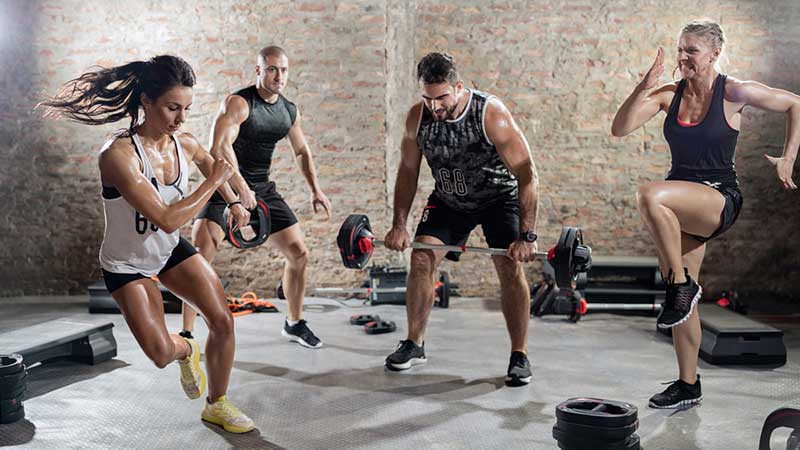
High-intensity training can improve health or fitness, or lead to dysfunction and injury, depending on how you go about it.
High-intensity training is a major fitness trend, and possibly the most common exercise approach used by individuals, groups, clubs and teams to improve athletic performance, and reduce body fat and weight.
Endurance athletes use sprints, intervals and resistance training to gain strength, increase speed and build endurance. Others lift weights, and participate in organized activities, such as Crossfit, Fitwall and Spin workouts at gyms. When these workouts involve intervals, they are known as high-intensity interval training, or HIIT.
Some athletes even do all of the above.
HIT can either help or it can hurt, depending on the individual, the intensity and duration, and the effectiveness of recovery. Avoiding the harm and getting more help from HIT requires participation from the brain.
While these activities have potential benefits, overdoing it with HIT also can increase the risk for damaged joints, disrupt hormones and harm the heart, plus cause chronic inflammation, pain, hormone imbalance, fatigue, depression and reduced athletic performance. It may also be the most common cause of physical, biochemical and mental-emotional impairment in both competitive athletes and others who exercise. In addition, despite burning a lot of exercise calories, many are unable to lose excess body fat and weight.
What is High Intensity?
For most people, high intensity is best measured by an increased heart rate (HR). Many athletes don’t realize the intensity level of their typical running or cycling pace, for example — it seems relatively slow, giving the impression of a low-intensity workout. But this slow-paced workout is often a high-intensity one in disguise. The solution is to use a heart-rate monitor to better regulate intensity. You can find the training heart rate that best matches your personal needs here.
High intensity also is often called anaerobic exercise. Those wanting to reduce excess body fat and weight, improve endurance and speed, and obtain health benefits from exercise, can accomplish all this with aerobic exercise performed throughout the year, along with shorter periods of HIT. This allows for better burning of stored fat, increased endurance at faster speeds, and many health benefits.
The key is to keep these types of workouts simple, short and to allow for adequate recovery time.
How HIT Helps
Healthy HIT can work wonders for the body, potentially improving physical, biochemical and mental-emotional well-being. The relatively minor stress of periodic HIT workouts can be a healthy stimulus for muscles and bones, hormones and immunity, pain tolerance, brain function and more, including better performance.
HIT benefits are dependent upon healthy lifestyle choices, such as with adequate nutrients obtained through healthy eating: in particular, the vitamins and minerals, protein and essential fats, and phytonutrients. Avoiding junk food is vital too.
HIT is most effective when workouts are balanced. It’s important not to exceed one’s speed limit. For example, if your goal is to run a race at a six minute-per-mile pace, performing intervals equivalent to five minute-per-mile pace may be harmful due to excess stress. In addition, shorter interval distances are very effective as most endurance athletes rarely if ever perform full sprints. For power or team sports like soccer, basketball, football and tennis, and for non-competitive exercisers, very short HIT distances or times are a low-stress way to get faster and healthy.
Maximum benefits from HIT typically occur with one to three sessions (more often one to two) per week. Beyond this frequency and timeframe, health risks may rise while benefits reduce.
Recovering from HIT helps bring benefits and is as important as the workout itself. This means seven to nine hours of quality sleep (not waking during the night). Reducing other workouts before and after HIT sessions also helps with recovery.
HIT helps more when following your personalized needs rather than working out with a group.
When HIT Hurts
It’s not normal to be injured, unhealthy or develop diminished performance from HIT (or at any other exercise), yet these are very common outcomes. Reduced recovery, poor diet, and excess training intensity are examples of excess stress — and can add to harmful effects of HIT.
The first sign of harm is a red flag that HIT is hurting us may arrive as excess muscle soreness or pain, fatigue, loss of vigor, or just not feeling right. This is the time to stop HIT to reassess the training and lifestyle schedule. It’s best to heed these clues before they progress to signs of inflammation/injuries, hormone imbalance, illness from reduced immunity, and performance decrements follow — all part of the overtraining spectrum.
Fortunately, the earliest sign that HIT is hurting us is easy to measure, as a reduction of submax performance — reduced speed or power at the same HR. In fact, it’s not unusual to get slower at the same submax HR when HIT turns harmful. (Normally, healthy training promotes faster paces or increased power at the same HR over time.)
High-intensity interval training has a place in almost every athlete’s repertoire of workouts, helping to build speed, strength and endurance. However, including this effective tool in your training strategy requires using your brain to make wise decisions regarding frequency and duration, as well as proper support through recovery and nutrition.
Burning Calories & HIT
Just burning more calories is not the goal of HIT or any other exercise. Health and fitness benefits occur when the body burns more stored fat calories. In healthy people, all levels of exercise intensities burn both fat and glucose. In general, as exercise intensity rises we burn less stored fat and more glucose. We train our metabolism to burn more fat through aerobic exercise, which increases fat-burning not only during exercise but throughout the day and night. This improves endurance as we burn more fat at higher intensities, and helps competitive performance as well.
View the app







